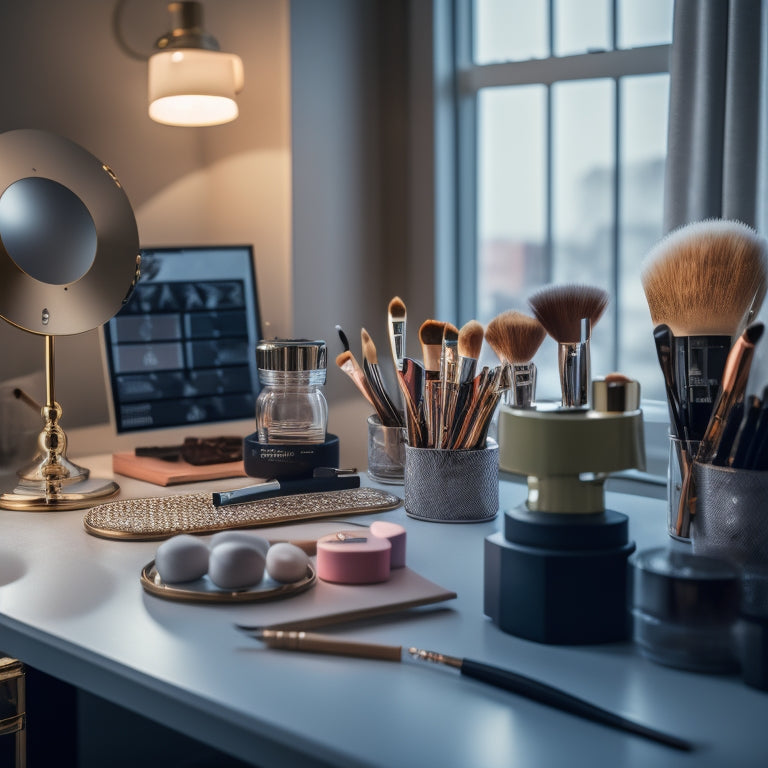
10 Time-Saving Tips for Busy Makeup Artists
Share
As a busy makeup artist, you know how important time management is to your success. Prioritize your schedule by identifying time-sensitive appointments and dedicating focused blocks of time to each client. Streamline your kit organization by purging unnecessary products and categorizing items by type. Master time blocking techniques to maximize productivity, and establish a morning routine to set yourself up for success. Effective communication and boundaries are also key - learn to say no politely and set clear expectations with clients. By implementing these strategies, you'll free up valuable time to focus on what matters most. Want to take your time-saving skills to the next level?
Key Takeaways
• Prioritize your makeup schedule by identifying time-sensitive appointments and allocating sufficient time for each client to minimize delays.
• Use time-blocking techniques to schedule focused 90-minute blocks dedicated to specific tasks or clients, avoiding context-switching and increasing productivity.
• Establish a consistent morning routine that includes meditation, reflection, and planning to set yourself up for success and clarity, saving up to an hour daily.
• Streamline your kit organization by purging unnecessary products, categorizing items, and checking for expired products to reduce waste and increase efficiency.
• Implement a daily workspace organization routine to ensure tools and products have designated places, avoiding wasted time searching for items and maximizing productivity.
Prioritize Your Makeup Schedule
To maximize your productivity, start by identifying your most time-sensitive appointments and scheduling them first, making sure that you allocate sufficient time for each client without compromising on quality. This is particularly important when you have multiple clients scheduled back-to-back. By prioritizing your schedule, you can minimize delays and guarantee a smooth workflow.
Implementing Schedule Hacks can greatly optimize your time management. One effective technique is to create Time Clusters, grouping similar tasks or clients together to minimize shift time. For instance, you can allocate specific time slots for bridal parties, individual clients, or special effects makeup. This clustering approach enables you to focus on a specific type of makeup without having to constantly switch gears.
Streamline Your Kit Organization
As you work to streamline your kit organization, you'll want to start by purging unnecessary products that are taking up valuable space.
Next, categorize your remaining products by type, grouping similar items together to make them easy to find when you need them.
Purge Unnecessary Products
Every makeup artist has a graveyard of forgotten products, but it's time to confront the reality: those dusty, expired, or duplicate items are suffocating your kit's efficiency. It's time to engage in some makeup archaeology and unearth the hidden gems in your kit.
Purging unnecessary products is vital to streamlining your kit organization. Here are three key areas to focus on:
-
Expired products: Check expiration dates and toss anything that's past its prime. You don't want to risk using expired products on clients, and it's a waste of space in your kit.
-
Duplicates: If you have multiple products that serve the same purpose, consider keeping only your favorite and letting go of the rest.
-
Unused items: Be honest with yourself – if you haven't used a product in the last six months, it's probably safe to let it go.
Categorize by Product Type
Now that you've purged your kit of unnecessary products, categorize your remaining items by product type to create a logical and accessible layout. This will save you time and frustration when searching for a specific product during a client session.
Start by grouping similar products together, such as foundations, concealers, powders, blushes, eyeshadows, mascaras, and lip products.
Within each category, organize products in a way that makes sense to you, like grouping your Foundation Favorites together or separating your Eyeshadow Essentials by shade or finish.
Consider using small containers or dividers to keep similar products contained and easy to grab. This system will help you quickly locate the product you need, ensuring a seamless and efficient makeup application process for your clients.
Masterful Time Blocking Techniques
Schedule your day into focused 90-minute blocks, dedicating each session to a specific task or client, and watch your productivity soar. This time-blocking technique allows you to tackle tasks without distractions, making sure you complete each task efficiently. By allocating specific times for tasks, you'll avoid context-switching, which can decrease productivity by up to 40%.
To take your time-blocking to the next level, try these techniques:
-
Batching Sessions: Group similar tasks together, such as applying makeup for multiple clients back-to-back. This reduces setup time and allows you to stay in a focused mindset.
-
Task Clustering: Divide large tasks into smaller, manageable chunks, and allocate specific time blocks for each chunk. This helps you stay organized and ensures you complete tasks on time.
-
Client Clustering: Schedule clients with similar needs or requirements together, reducing the time spent on switching between tasks and allowing you to provide more personalized attention.
Efficient Client Communication
As a busy makeup artist, you know that effective client communication is key to saving time and reducing stress.
By establishing clear expectations, setting boundaries early, and asking open-ended questions, you can guarantee that you're on the same page as your clients from the get-go.
Clear Expectations
What's the most common source of frustration in your makeup artistry business: miscommunication with clients about their desired look, or unrealistic expectations about what can be achieved in a single session?
To avoid these issues, establishing clear expectations from the get-go is crucial. Here are three essential tips to help you set the tone for a successful collaboration:
-
Contract Clarity: Guarantee your contract outlines the scope of work, payment terms, and cancellation policies. This will prevent misunderstandings and protect your business.
-
Boundary Scripts: Prepare scripts that outline your boundaries and limitations. For instance, you might've a script for when a client requests an unrealistic look or wants to add services beyond what's included in the contract.
-
Realistic Goal-Setting: Discuss and agree upon achievable goals with your clients. This will help manage their expectations and ensure you're both on the same page.
Set Boundaries Early
By establishing boundaries early, you can prevent scope creep and guarantee that your clients understand what they can realistically expect from your services, freeing you up to focus on the creative aspects of your work.
Effective boundary setting is vital to maintaining a healthy and efficient client relationship. When you clearly communicate your capabilities and limitations, you avoid the risks of overcommitting, which can lead to burnout and compromised quality of work.
By establishing clear expectations, you ensure that clients understand what's included in your services and what's not, preventing misunderstandings and scope creep. This, in turn, helps you manage your time more efficiently, allocate resources effectively, and maintain a high level of quality in your work.
Ask Open-Ended Questions
When gathering information from clients, you'll elicit more detailed and revealing responses by asking open-ended questions that encourage them to share their thoughts and expectations freely. This approach helps you better understand their needs and preferences, ensuring you deliver a customized service that meets their expectations.
To get the most out of your client interactions, focus on crafting questions that can't be answered with a simple 'yes' or 'no.' Here are some tips to refine your question phrasing:
-
Avoid leading questions: Phrase your questions to avoid influencing the client's response. Instead, ask neutral, open-ended questions that allow them to express their thoughts freely.
-
Use what, how, and why questions: These types of questions encourage clients to share more detailed information about their needs and expectations.
-
Seek clarification: Don't be afraid to ask follow-up questions to clarify any unclear or ambiguous responses.
Declutter Your Workspace Daily
To maximize your productivity, dedicate a few minutes each day to tidying up your workspace, ensuring that every tool, product, and equipment has its designated place. This habit will save you time and energy in the long run, allowing you to focus on what matters most – delivering exceptional makeup services to your clients.
By adopting daily workspace habits, you'll avoid wasting precious minutes searching for misplaced items or cleaning up cluttered messes.
Develop a daily routine that works for you, whether it's tidying up at the end of each client session or setting aside 10 minutes at the start of your day to organize your workspace. Make it a habit to put away products, wipe down surfaces, and sanitize your tools.
A clutter-free workspace not only boosts your efficiency but also contributes to a more professional and hygienic environment for your clients.
Simplify Your Product Inventory
You'll save time and reduce frustration by categorizing and streamlining your product inventory, making sure you can quickly locate the right shades, formulas, and tools for each client's unique needs.
To simplify your product inventory, try these inventory hacks:
-
Group similar products together: Store all your foundations, concealers, or eyeshadows in designated areas, making it simple to find what you need at a glance.
-
Implement a 'first in, first out' system: Guarantee older products are used before they expire, reducing waste and saving you money.
-
Schedule regular product swaps: Rotate your products every 6-12 months to make sure you're using the freshest products and avoiding expired or spoiled items.
Create a Morning Routine
Establishing a consistent morning routine saves you up to an hour daily, freeing you to tackle more pressing tasks or simply enjoy a quiet cup of coffee before the chaos begins.
By incorporating mindful meditation into your morning routine, you'll set yourself up for success and clarity throughout the day. Take 10-15 minutes each morning to focus on your breath, quiet your mind, and center yourself. This will help you stay present and focused, even on the most chaotic of days.
To optimize your morning routine, take a few minutes each evening to reflect on your accomplishments and plan for the next day. This evening reflection will help you prioritize tasks, make adjustments as needed, and make sure you're on track to meet your goals. By doing so, you'll wake up feeling more in control and prepared to tackle the day ahead.
Learn to Say No Politely
As a busy makeup artist, you know that taking on too much can lead to burnout and decreased productivity. To maintain your energy and focus, it's crucial to learn how to say no politely, and that starts with setting clear boundaries from the get-go.
Set Boundaries Early
Establishing clear boundaries from the outset is crucial to protect your time and energy from unnecessary drains, ensuring a more streamlined and productive workflow. As a busy makeup artist, establishing healthy limits is vital to maintain a sustainable pace. Boundary pushing clients can quickly deplete your resources, leaving you exhausted and demotivated.
To avoid this, set clear expectations from the start. Here are three essential boundaries to establish:
-
Define your work hours: Clearly communicate your availability to clients and stick to it. This will help prevent late-night calls and last-minute requests.
-
Establish a booking policy: Set a minimum notice period for bookings and cancellations to avoid last-minute changes.
-
Set realistic expectations: Be upfront about what you can realistically achieve in a session, avoiding overpromising and underdelivering.
Prioritize Your Energy
Frequently, you'll encounter requests that, although flattering, can drain your energy and derail your schedule, making it essential to learn how to say no politely.
As a busy makeup artist, managing your energy is vital to maintaining your physical and mental well-being. Prioritizing your energy means being intentional about how you allocate your time and resources. This requires adopting self-care habits that promote energy conservation, such as getting adequate rest, exercising regularly, and eating nutritious food.
Effective energy management also involves setting realistic boundaries and learning to say no to requests that don't align with your priorities or values. By doing so, you'll conserve your energy for tasks that truly matter, allowing you to serve your clients with excellence and enthusiasm.
Remember, saying no to others means saying yes to yourself, and that's essential for sustaining a thriving career as a makeup artist.
Respectful Decline Scripts
When faced with requests that don't align with your priorities, having a solid script can help you decline politely while maintaining a professional tone.
As a busy makeup artist, you can't take on every job or commitment that comes your way. Learning to say no politely is essential to protecting your time and energy.
Here are three script templates to help you craft polite refusals:
-
The Gracious Decline:
'Thank you so much for thinking of me for this opportunity. Unfortunately, I've prior commitments that I need to attend to. I appreciate your understanding.' -
The Redirect:
'I appreciate your interest in working with me, but I'm not the best fit for this project. I can recommend a colleague who might be a better fit.' -
The Honest But Firm:
'I appreciate the offer, but I need to prioritize my existing commitments. I'm not able to take on any new projects at this time. Thank you for understanding.'
These script templates will help you communicate your boundaries clearly and respectfully, allowing you to maintain a professional reputation while protecting your time and energy.
Outsource and Delegate Tasks
As a busy makeup artist, you can free up more time for high-priority tasks by identifying tasks that can be outsourced or delegated to others, such as scheduling, bookkeeping, or social media management. By doing so, you can focus on what matters most - providing exceptional service to your clients. Consider hiring a Virtual Assistant to manage your calendar, respond to inquiries, and update your social media profiles. This won't only save you time but also guarantee that these tasks are completed efficiently and accurately.
Effective Task Management is key to successful delegation. Make a list of tasks that can be delegated and prioritize them based on importance and urgency. Identify the skills and expertise required for each task and delegate accordingly. By outsourcing and delegating tasks, you can reduce your workload, minimize stress, and increase productivity. This will enable you to focus on high-leverage activities that drive your business forward, such as networking, marketing, and providing exceptional services to your clients.
Leverage Technology for Automation
By automating repetitive tasks, you can redirect your energy towards high-impact activities that drive business growth, such as refining your craft, building relationships, and expanding your network.
As a busy makeup artist, you know how time-consuming administrative tasks can be. That's where technology comes in. By leveraging digital tools, you can streamline your workflow and free up more time for what matters most - making your clients look and feel amazing.
Here are three ways to get started:
-
Digital Assistants:
Integrate virtual assistants like Siri, Google Assistant, or Alexa to set reminders, schedule appointments, and even respond to routine client inquiries. -
Automated Reminders:
Set up automated reminders for appointments, follow-ups, and important deadlines to make sure you're always on top of your schedule. -
Scheduling Tools:
Utilize online scheduling tools to allow clients to book appointments at their convenience, reducing the back-and-forth of finding a mutually available time.
Frequently Asked Questions
How Do I Handle Last-Minute Client Cancellations or No-Shows?
When clients cancel or no-show, you're left scrambling; implement overcommunication strategies to set clear expectations, and establish cancellation policies to protect your time, ensuring you're prepared for last-minute changes and minimizing losses.
What if I'm Not a Morning Person, Can I Still Be Productive?
You can still be productive, even as a night owl, by adjusting your schedule to suit your natural rhythms, focusing on an evening routine that maximizes your energy and creativity.
Can I Still Use This Advice if I'm a Freelance Makeup Artist?
As a freelance makeup artist, you can still leverage these tips to boost your productivity. Your freelance flexibility and artist autonomy allow you to tailor these strategies to your unique schedule and client needs.
How Do I Set Boundaries With Clients Who Constantly Text?
"Did you know 67% of entrepreneurs feel burned out due to overcommitting? You set boundaries with clients by defining clear Client Expectations and having scripted responses, aka Boundary Scripts, ready to politely yet firmly communicate your limits, ensuring a healthier work-life balance."
What if I'm Not Tech-Savvy, Can I Still Automate Tasks?
You don't have to be tech-savvy to automate tasks; digital assistants and simplified software can help you streamline processes, freeing up time for what matters - serving your clients and growing your business.
Related Posts
-

Best Dance Footwear for Comfort and Performance
When selecting the best dance footwear for comfort and performance, prioritize shoes with exceptional arch support an...
-

Hip Hop Dance Studies: A Comprehensive Guide
Hip hop dance, born from the intersection of music, culture, and movement, has evolved into a global phenomenon, inco...
-

Frozen Frenzy: Creative Crafts Galore
We're entering a winter wonderland of creativity, where snowflakes sparkle, ice castles shine, and magic unfolds in e...


